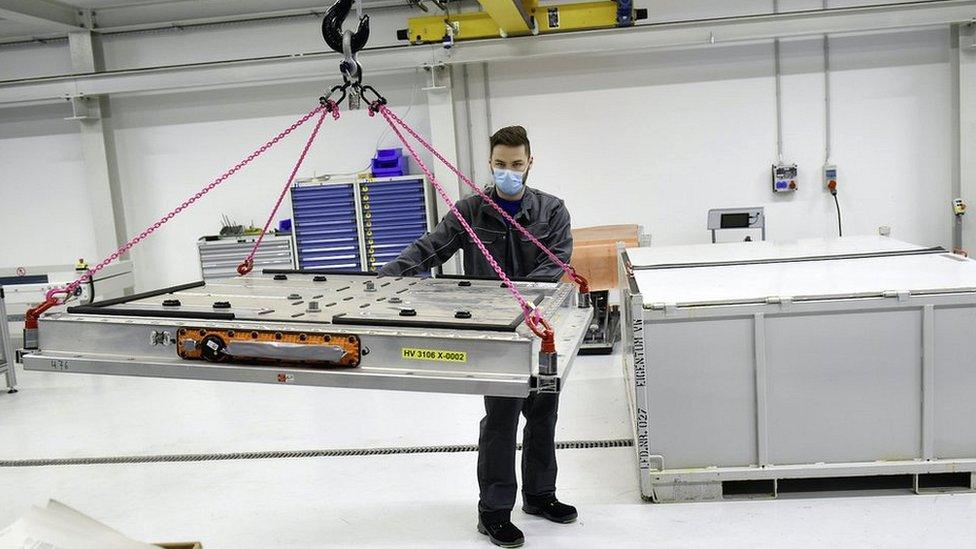How easy is it to drive across Wales in an electric car?
- Published
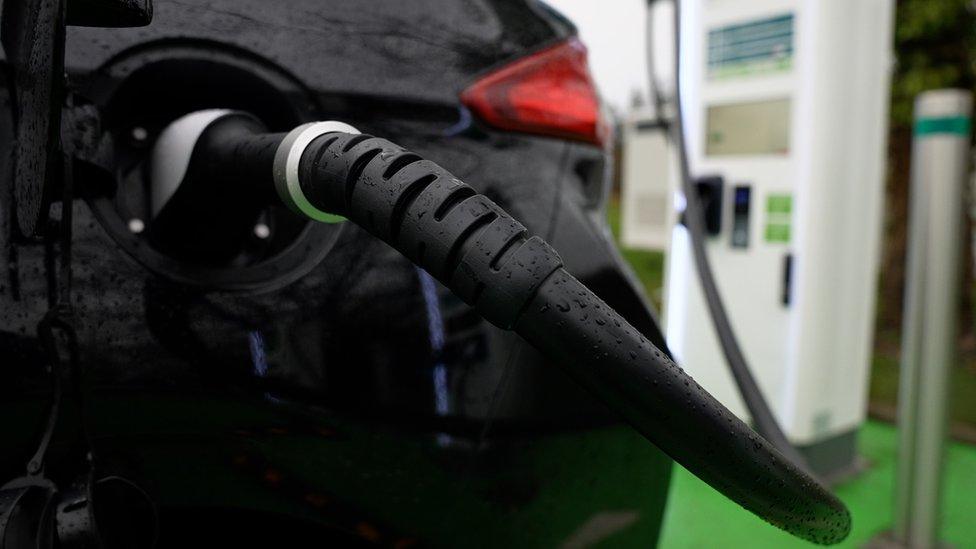
It's less than eight years before the sale of new petrol and diesel cars is banned in the UK - and sales of electric vehicles have been rising steeply.
Yet surveys suggest, external that concern over the state of the UK's charging infrastructure is now the number one reason stopping newer buyers from taking the plunge.
To see if those fears were justified, I attempted to drive up and down Wales in a standard electric car to see how easy it would be.
Leaving Cardiff
It's 175 miles from my home in Cardiff to Nefyn, in the picturesque Llyn Peninsula, north Wales in a BBC electric pool car.
The car's range was less than the this trip's length, but about standard for your average second-hand electric vehicle (the latest models could do this one-way trip without stopping).
I drove there on rural roads, and then came back via the M4, Wales' only motorway, and see if there were enough chargers on both routes.
I had planned to go via the quickest satnav route, via Builth Wells and Llanidloes, along the A470, Wales' main route from South to the North.
But, having discovered there were only four "rapid" public chargers between Cardiff and Nefyn for my journey, I had to change my journey in order to avoid stopping for a much longer period, and to avoid being stranded in rural mid Wales.
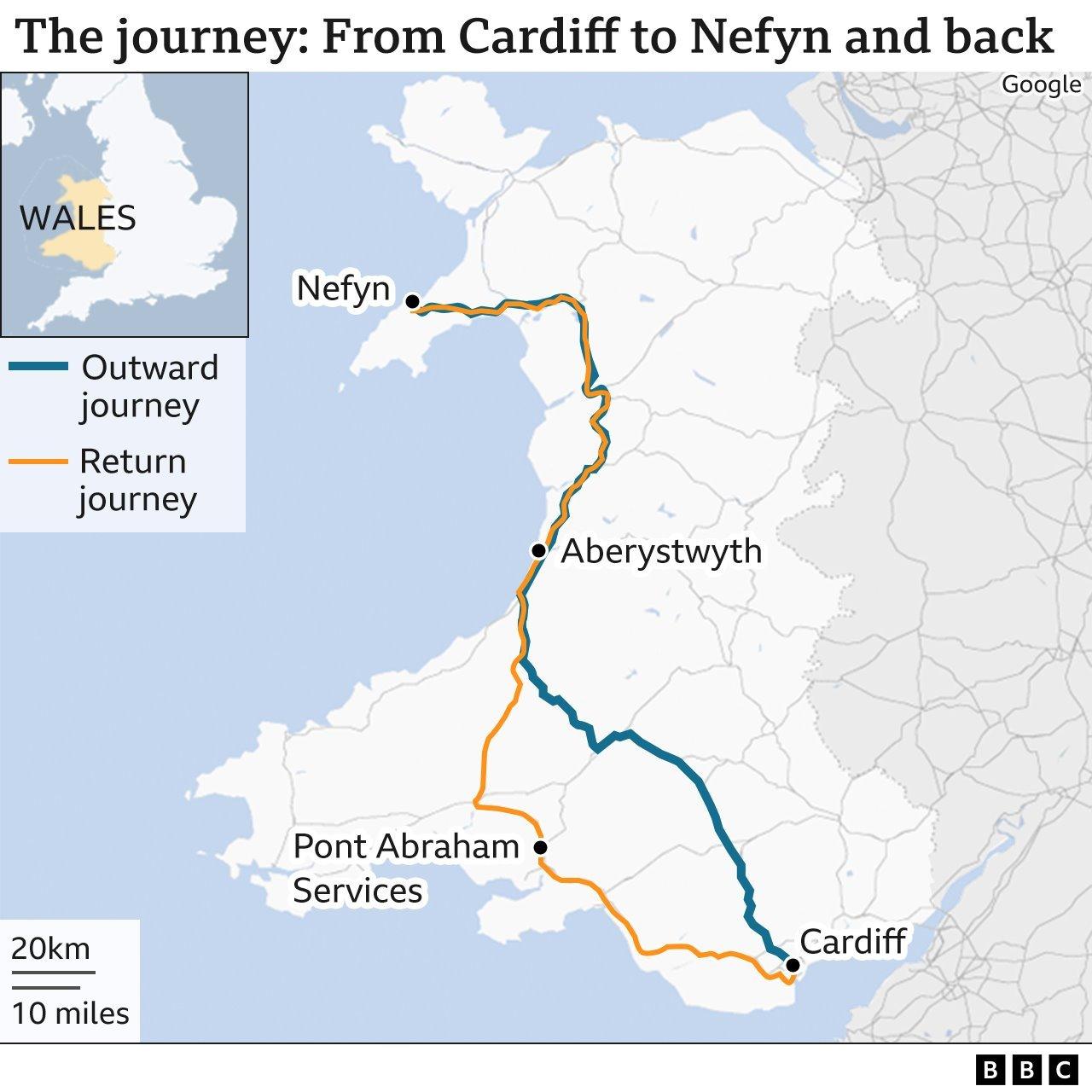
If you talk to any EV driver - like myself who's owned one for the past two years - they will tell you that planning is key for a long journey.
That's not planning where the best coffee can be found in rural mid-Wales, but figuring out where you'll be able to stop to charge.
Some drivers talk of "range anxiety" - a fear that the electric vehicle will not have enough charge to make it to the next working charge point.
Finding a working charger is one thing - but finding one that will charge your vehicle quickly is another potential pitfall. Rapid and ultra-rapid chargers - capable of charging a standard EV to around 80% in around an hour or less - are the ones drivers seek out.
Scotland and south-east England boast the highest number of rapid chargers, and have a good number of slower chargers as well. But Northern Ireland, Wales and north-east England are behind.

In the end, I travelled via Llanymyddfri and Aberystwyth, which provided more charging options and better peace of mind.
Despite my forward planning, I still reached Aberystwyth with just 15 miles left in the tank. In fact, I had to turn off the satnav, air con and the radio to make sure I had enough power to get there.
Of the two public rapid chargers within a roughly 25-mile radius, one was already being used. So I headed to a supermarket on the outskirts of town.
Much to the annoyance of Julie Williams and Matthew Jones, I got there before them.
You lose hours of your holiday travelling to make sure you have enough charge to get home
EV owners for the past year and a half, they'd driven from Birmingham to the west coast of Wales for a holiday. With no charger at their holiday cottage, they'd had to forgo a dip in their hot tub this lunchtime to find somewhere to charge.
"You lose hours of your holiday travelling to make sure you have enough charge to get home," Matthew said.
"There's not the services out there to feel confident to go on a journey like we've done from Birmingham to know we can go to any service station to charge," Julie added. "You have to search and hope that they're working."
Snapshot figures for March, seen exclusively by the BBC and supplied by Zap-Map, suggest that at any time around one in 10 rapid or ultra-rapid devices in the UK are out of service.
Furthermore, a survey of more than 1,000 drivers by the Electric Vehicle Association England (EVA) suggested owners were broadly dissatisfied with their charging experience - rating it 2.16 out of five.
In its recent charging infrastructure strategy, the UK government set a future target for 99% of all rapid chargers to be working at any one time.
The government says it will begin penalising operators by the end of 2023 if they don't meet with standards on reliability.
Problems at the hotel
Aberystwyth had pretty typical coverage for a small town - a few rapid chargers and a handful of slower or "trickle" chargers dotted around.
But at our overnight destination in Nefyn, on the Llyn Peninsula, there were fewer than 10 public chargers. They were all slow speed, many on holiday parks or at hotels.
I had 30 miles left when I arrived. With no public charger at the hotel, I had to leave my car overnight in a public car park, five minutes away. Had this one not been working it would have meant leaving the car even further away.
Luckily Alex, our cameraman, had his own vehicle so he could taxi me back and forth. Without him, it would have meant even more forward planning.
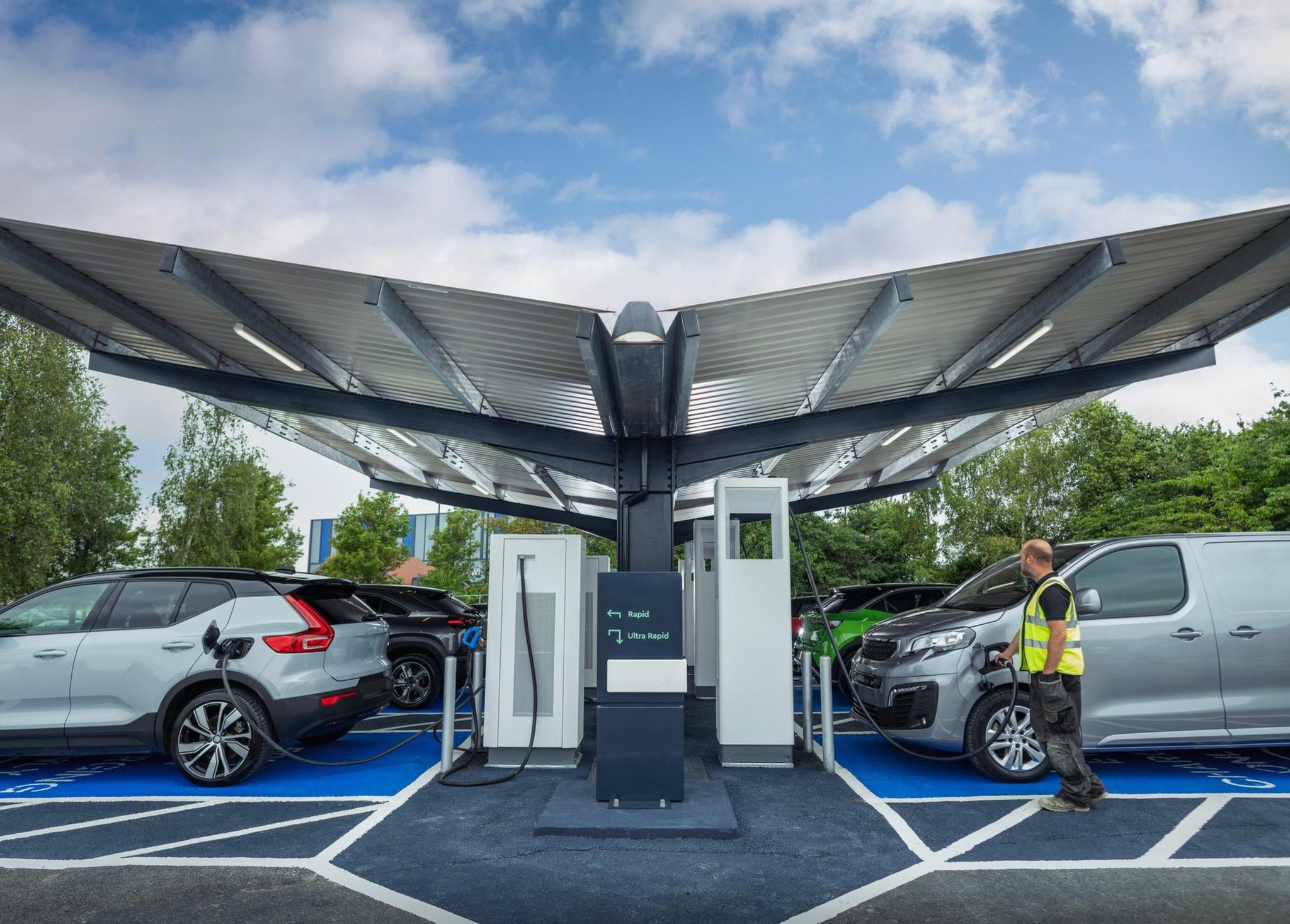
Charging stations are being built in some parts of the UK - including York - but other areas are still lacking
One reason there aren't as many chargers in rural and holiday destinations - especially faster ones - is commercial viability.
The competition and marketing authority has said there is a risk areas like north-west Wales could become "charging deserts" because of a poor commercial case for installing public chargers.
In its EV infrastructure strategy, the UK government set a target of installing 300,000 public chargers by 2030. It pledged £1.6bn to be used "in support of charging infrastructure".
But cost is a huge factor - devices aren't cheap to install. An average rapid charger costs £20,000-£30,000, according to Dr Euan McTurk, a consultant battery electrochemist.
"And then you've got to install them on top of that. A grid connection, if it's required, might be £10,000- £15,000," he says.
Back on the M4
On my way home, I opted to stop at Aberystwyth again, before ending the last 50-odd miles via the M4.
A recent change in supplier has meant that many motorway service stations are finally getting a much-needed upgrade in their charging facility - Gridserve is now top dog.
It runs Wales' only ultra-rapid charging hub, located on junction 47 on the outskirts of Swansea. When I arrived, the hub had been operational for only two weeks.
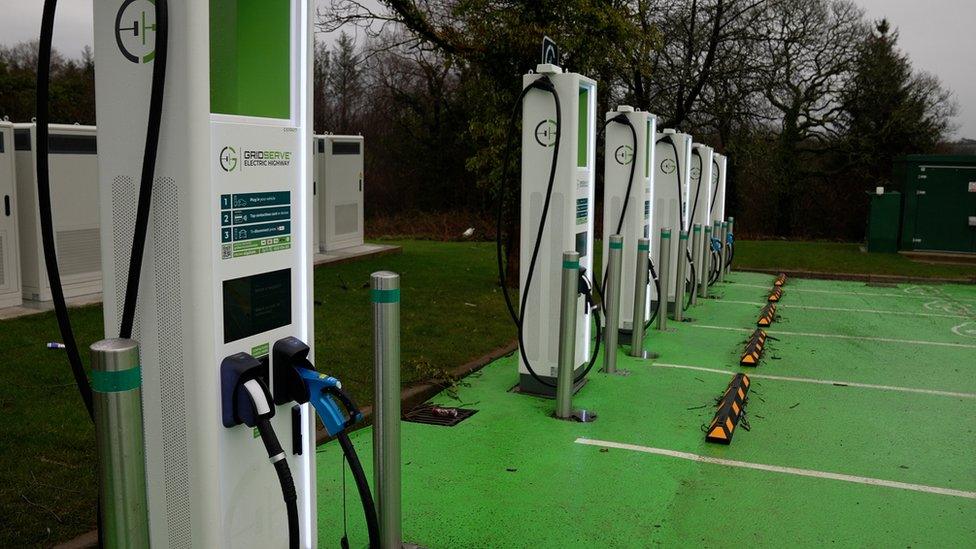
The ultra-fast hub, outside Swansea
Yet I soon found customers who had experienced problems with this new facility.
Myself and Neville Price, who's had his Audi E-tron since November, managed to call Gridserve and the situation was resolved with a machine reset. Neville told me that "you've got to have a backup" for situations like this.
"I've had a lot of range anxiety, my wife can attest to that," said another man powering up here. "Trying to find the right charger, trying to find a charger that works, and trying to find enough of them are the main issues."
Gridserve says it has a 24-hour a day phone team to help customers, and an average working rate of 98% across their devices.
Frustrating... but possible
My journey was not painless. At times it was frustrating and slower than planned - but it was possible.
The Welsh Government say it is "working with the UK government to expand the charging network in Wales". Although transport is partially devolved, this area does require UK government engagement.
If the UK government delivers on its promised rapid expansion of chargers across the UK, EV chargers will become far more visible across the country.
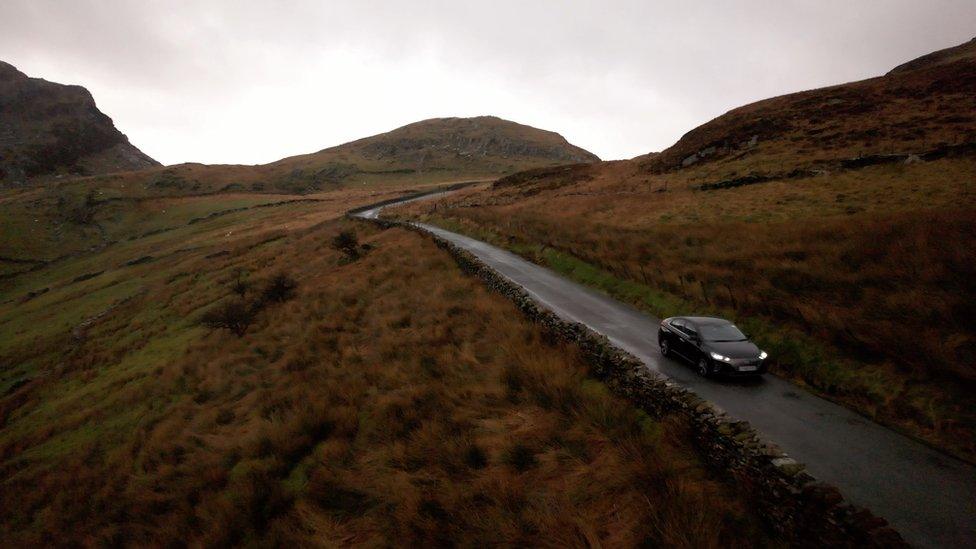
Our journey was from Cardiff to Nefyn, in the picturesque Llyn Peninsula, in north Wales
But James Court, from EVA England, says reliability and gaining the trust of drivers is vital. He said holding providers to account will also be important.
"We'd want to make sure that there is a real penalty for CPOs [charge point operators] not reaching those reliability targets because it makes a real difference," he added.
In a statement a spokesperson from the Department for Transport said "public ChargePoint reliability is improving". It said the government was working on setting out "how regulations will be enforced to a good consumer experience across the UK".
But as the electric horizon moves ever closer, the scale of completing this challenge shouldn't be underestimated, or underpowered.
Additional reporting by Becky Dale, Senior Data Journalist.

MONUMENTAL MRS CAMPBELL: Wales' first black head teacher celebrated with iconic statue
MOTHERS, MISSILES AND THE AMERICAN PRESIDENT: The story of Greenham told like never before

Related topics
- Published6 January 2022

- Published1 June 2021

- Published27 April 2021
